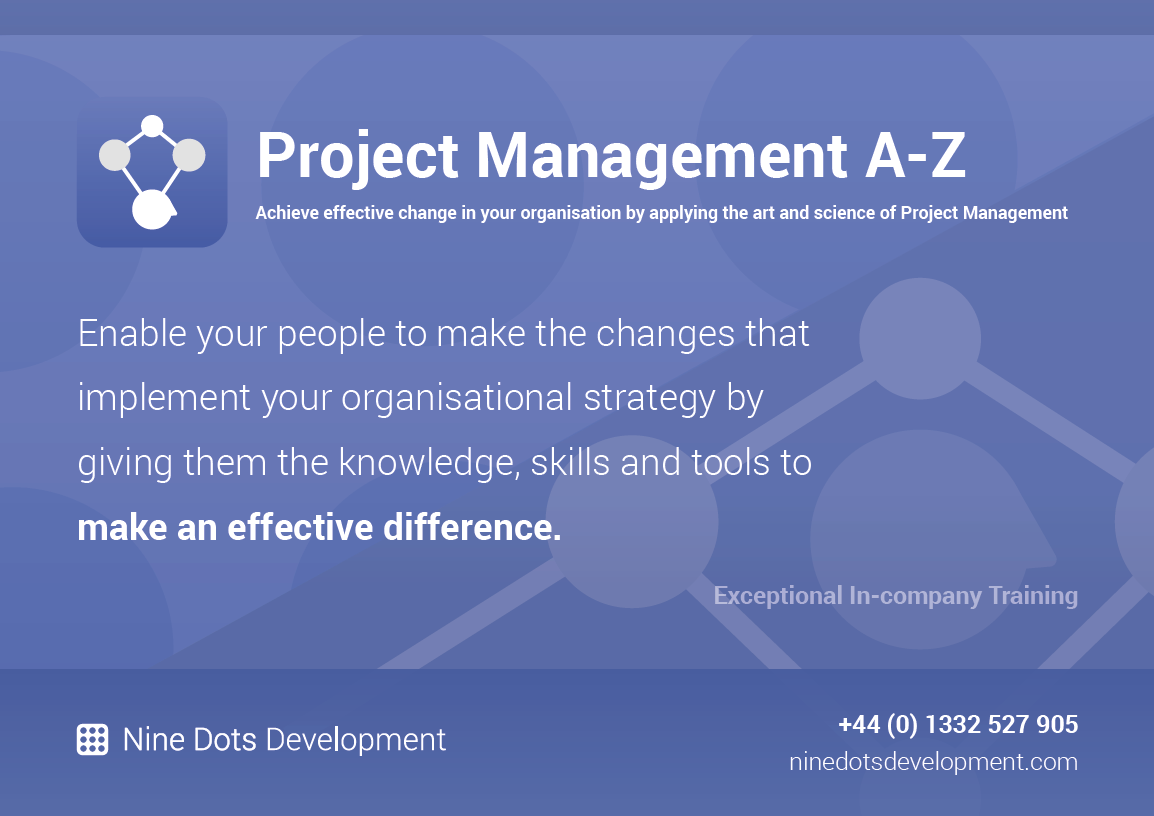Tuesday 02 Nov 2021 Article
The Takeaway[Phase Two] How to Run a Smooth-sailing Cross-departmental Project
Getting and Keeping Stakeholders on Your Side
Part 3
#FundedTraining #HR #Change #BusinessPlans #RACI #Communication #Stakeholders #ProjectManagement #PersonalDevelopment
The perfectly matched resource for this article...
Our Project Management A-Z Training Programme
Initiating projects, managing stakeholders, and creating effective communication plans are all fundamentals of project management. If you or your staff struggle with project management, our Project Management A-Z training programme would be perfect for you.
Download brochure![Phase Two] How to Run a Smooth-sailing Cross-departmental Project
Following on from our previous article… You now have your stakeholder-centric initiation outline together; it’s engaging, motivating, and ready to go.
What’s next? It’s time to present the project to stakeholders, decide how it will be carried out, and get everyone excited. At least that’s the plan - often it doesn’t go that way.
In today’s article, we explain how to present your project initiation outline and create a communication plan to keep stakeholders happy and on your side.
09:30 am Tuesday: Launch Day
It’s 09:30am the following day and everyone has just got to the office. You look around, beaming, excited to present the initiation outline that you worked so hard on yesterday. You want to immediately gather everyone into a meeting, but instead you contain your excitement as you understand that everyone would likely appreciate some time to plan their day, check their emails and settle down before you try to drag them into a meeting. Instead, you make a list of stakeholders that need to be involved and you put a meeting in the diary for 10:30am. You’re about to press ‘Send Invites’ but then you take another look at the name of the meeting - “Performance Monitoring Project Initiation”. “It’s too dull” you think to yourself - and you’re right. The name of the meeting is going to set the tone for your presentation, so you draft several different names and finally settle on “Exciting News: We’re Scrapping Annual Appraisals”. Much better - more enticing, engaging, and not “dull”. You press ‘Send Invites’ and before you know it, everyone has accepted the meeting invitation.

You look at your watch - 09:40 - you have 50 minutes until the meeting starts. In that time, you do everything you can to be as prepared as possible - you print a copy of the initiation outline for each attendee, you create a blank RACI to fill out in the meeting, and you make a note of all of the things you want to talk about. Before you know it, it’s 10:25 and you go to set up in the meeting room, hands slightly trembling as you lay out the handouts neatly across the table.
10:30 am Tuesday: Show Time!
At 10:28 am, attendees begin to pile into the room - for once everyone is on time - and you can sense an atmosphere of excitement and intrigue in the room. Annual appraisals are a huge part of most organisations’ talent management process, so announcing that you’re getting rid of them is bound to turn some heads and get everyone’s attention.
10:30 - show time!
You begin your presentation by thanking everyone for making time for this meeting so last minute as you appreciate that they’re all likely very busy. With great excitement, you announce that you will be leading a project to redesign the current performance monitoring process, moving from annual appraisals to monthly performance catch-ups. You see smiles spread across everyone’s faces - the dreaded annual appraisals are gone! You go on to explain that this will be done in 1 month, and that the reason for the project is to support employees and make them more productive in their roles. You go on to explain all of the benefits to each of the 3 groups of stakeholders that you listed in your initiation outline:

You continue and fill out the RACI you’ve prepared, identifying exactly what will be done, who by, and when, and as with most projects, the timescales aren’t ideal but they’re manageable and everyone is excited and eager to pitch in. It’s now 12:15pm, everything is going well, everyone is on-board (so far), so you decide to break for lunch and reconvene in 45 mins, at 1pm.
1:00pm Tuesday: The Downfall
Again, the room fills with people, and they all seem re-energised after a nice long lunch break. The last part of your project initiation presentation is all about stakeholder communication. Seems simple, right? Just hold a video catch up every Friday afternoon at the end of the day. This seems logical - doing it at the end of the day means that everyone can get the work they need to do finished beforehand so they aren’t stressed and wanting the meeting to hurry up and end, and doing it on Friday allows the perfect opportunity to report on the week’s progress.
But this is where the presentation goes wrong, you fall at that final hurdle.
When you share this proposed communication plan, the smiles practically vanish off everyone’s face. You can tell they’re not happy. Not anticipating this response, you feel flustered and rush through the rest of your presentation, recapping the benefits to each of the stakeholder groups in an attempt to get them back on-side - but it doesn’t work.
{{ADVERT}}
“Why aren’t they happy?” you think to yourself. Instead of just ignoring their dissatisfaction, you decide to get everyone together again and ask why weekly Friday afternoon catch-ups don’t work for them, and what they’d prefer instead. You soon find some trends and patterns:
- Friday’s are often people’s busiest days as they’re trying to get everything done before the weekend
- Towards the end of the day, especially on Friday, people are tired and not in the right mindset for a meeting
- Video calls aren’t everyone’s cup of tea as they can take up a lot of time - some people, especially SLT, would prefer an email update, and a video call bi-weekly instead of weekly
- Employees that will be most involved in the project want updates more frequently than once a week as they feel like they’d miss out on valuable information
Using this information, you craft a well thought-through, personalised stakeholder communication plan. (You can click here to read an article all about how to create an effective communication plan).
Finally, the project is planned, stakeholders are happy, and everyone knows what they need to do - you’re on the path to success.
Struggling with Project Management?
Initiating projects, managing stakeholders, and creating effective communication plans are all fundamentals of project management.
If you or your staff struggle with project management, our Project Management A-Z training programme would be perfect for you. Over 7 workshops, this programme covers:
- Fundamentals of Project Management
- Introduction to Agile
- Scheduling for Confidence
- Soft Skills for Project Managers
- Agile Project Management
- Winning Hearts and Minds
- Benefits Management
To find out more about this programme, click here to download our brochure, call our office on 01332 527 905, or click here to request a call with one of our training experts.
---
Next time on the Daily Dot, we will be looking at how to make the execution of projects as smooth and efficient as possible.
Until next time...
Our Project Management A-Z Training Programme
Initiating projects, managing stakeholders, and creating effective communication plans are all fundamentals of project management. If you or your staff struggle with project management, our Project Management A-Z training programme would be perfect for you.
Download brochure!Missed an article?
More from Getting and Keeping Stakeholders on Your Side
